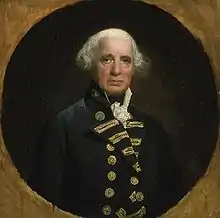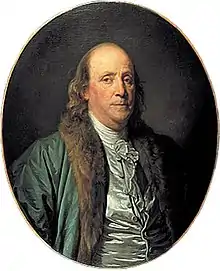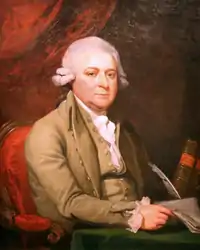Staten Island Peace Conference
The Staten Island Peace Conference was a brief informal diplomatic conference held between representatives of the British Crown and its rebellious North American colonies in the hope of bringing a rapid end to the nascent American Revolution. The conference took place on September 11, 1776, a few days after the British had captured Long Island and less than three months after the formal American Declaration of Independence. The conference was held at Billop Manor, the residence of loyalist Colonel Christopher Billop, on Staten Island, New York. The participants were the British Admiral Lord Richard Howe, and members of the Second Continental Congress John Adams, Benjamin Franklin, and Edward Rutledge.

Upon being placed in command of British land forces in the Colonies, Lord Howe had sought authority to resolve the conflict peacefully. However, his power to negotiate was by design extremely limited, which left the Congressional delegation pessimistic over a summary resolution. The Americans insisted on recognition of their recently-declared independence, which Howe was unable to grant. After just three hours, the delegates retired, and the British resumed their military campaign to control New York City.
Background

When British authorities were planning how to deal with their rebellious North American colonies in late 1775 and early 1776, they decided to send a large military expedition to occupy New York City. Two brothers, Admiral Lord Richard Howe and General William Howe, were given command of the naval and land aspects of the operation respectively. Since they believed that it might still be possible to end the dispute without further violence, the Howe brothers insisted on being granted diplomatic powers in addition to their military roles.[1]
Admiral Howe had previously discussed colonial grievances informally with Benjamin Franklin in 1774 and 1775, without resolution. General Howe believed that the problem of colonial taxation could be resolved with the retention of the supremacy of Parliament.[2]
At first, King George III reluctantly agreed to grant the Howes limited powers, but Lord George Germain took a harder line by insisting for the Howes not to be given any powers that might be seen as giving in to the colonial demands for relief from taxation without representation or the so-called Intolerable Acts. As a consequence, the Howes were granted the ability only to issue pardons and amnesties, not to make any substantive concessions.[1] The commissioners were also mandated to seek dissolution of the Continental Congress, the re-establishment of the prewar colonial assemblies, the acceptance of the terms of Lord North's Conciliatory Resolution regarding self-taxation, and the promise of a further discussion of colonial grievances. No concessions could be made unless hostilities were ended, and colonial assemblies made specific admissions of parliamentary supremacy.[3]

After the fleet arrived in July 1776, Admiral Howe made several attempts to open communications with Continental Army General George Washington. Two attempts to deliver letters to Washington were rebuffed because Howe had refused to recognize Washington's title. Washington, however, agreed to meet in person with one of Howe's adjutants, Colonel James Patterson. In the meeting on July 20, Washington learned that the Howes' diplomatic powers were essentially limited to the granting of pardons; Washington responded that the Americans had not committed any faults and so did not need pardons.[4]
Lord Howe then sent a letter to Benjamin Franklin that detailed a proposal for a truce and offers of pardons.[5] After Franklin read the letter in Congress on July 30, he wrote back to the Admiral, "Directing pardons to be offered to the colonies, who are the very parties injured,... can have no other effect than that of increasing our resentments. It is impossible we should think of submission to a government that has with the most wanton barbarity and cruelty burnt our defenseless town,... excited the savages to massacre our peaceful farmers, and our slaves to murder their masters, and is even now bringing foreign mercenaries to deluge our settlements with blood."[6] He also pointed out that "you once gave me expectations that reconciliation might take place."[6] Howe was apparently somewhat taken aback by Franklin's forceful response.[6]
"Some think it will occasion a delay of military operations; which we much want. I am not of that mind. Some think it will clearly throw the odium of continuing this war on his Lordship and his master. I wish it may. Others think it will silence the Tories and establish the timid Whigs. I wish this also, but do not expect it. All these arguments, and twenty others as mighty, would not have convinced me of the necessity, propriety, or utility, if Congress had not determined on it. I was against it from first to last. All sides agreed in sending me. You will hear more of this embassy. It will be famous enough."
John Adams to James Warren, September 8, 1776[7]
During the Battle of Long Island on August 27, 1776, British forces successfully occupied western Long Island (modern Brooklyn), which compelled Washington to withdraw his army to Manhattan.[8] General Howe then paused to consolidate his gains, and the brothers decided to make a diplomatic overture. During the battle, they had captured several high-ranking Continental Army officers, including Major General John Sullivan. The Howes managed to convince Sullivan that a conference with members of the Continental Congress might yield fruit and released him on parole to deliver a message to the Congress in Philadelphia[9] that proposed an informal meeting to discuss ending the armed conflict between Britain and its rebellious colonies. After Sullivan's speech to Congress, John Adams cynically commented on this diplomatic attempt by calling Sullivan a "decoy-duck" and accusing the British of sending Sullivan "to seduce us into a renunciation of our independence." Others noted that it appeared to be an attempt to blame Congress for prolonging the war.[10][11]
Congress, however, agreed to send three of its members (Adams, Benjamin Franklin, and Edward Rutledge) to a conference with Lord Howe.[7] They were instructed "to ask a few Questions and take [Howe's] Answers" but had no further authority.[12] When Howe learned of the committee's limited authority, he briefly considered calling the meeting off but decided to proceed after he had discussed with his brother.[13] None of the commissioners believed that the conference would amount to anything.[7]
Lord Howe initially sought to meet with the men as private citizens since British policy did not recognize the Congress as a legitimate authority.[14] For the conference to take place, he agreed to the American demand to be recognized as official representatives of the Congress.[15][16]
Meeting

The house of Christopher Billop, on Staten Island, was selected to be the meeting place. It had been occupied by British troops for use as a barracks and was in filthy condition, but one room was cleaned and prepared for the meeting.[16] The arrangements included one British officer to be left on the American side as a hostage during the meeting. The congressional delegation, rather than leaving him behind the American lines, invited him to accompany them. On arrival, the delegation was escorted past a line of Hessian soldiers and into the house, where, according to Adams, a repast of claret, ham, mutton, and tongue was served.[17]
The meeting lasted three hours, but the two sides were unable to find any common ground.[18] The Americans insisted that any negotiations required the British recognition of their recently-declared independence. Lord Howe stated that he did not have the authority to meet that demand.[19] When asked by Edward Rutledge whether he had the authority to repeal the Prohibitory Act, which authorized a naval blockade of the colonies, as had been claimed by Sullivan,[12] Howe demurred and claimed that Sullivan was mistaken. Howe's authority included the ability to suspend its execution if the colonies agreed to make fixed contributions, instead of the taxes that Parliament had levied on them. None of that could be done unless the colonies first agreed to end hostilities.[20]
For most of the meeting, both sides were cordial. However, when Lord Howe expressed that he would feel America's loss "like the loss of a brother," Franklin informed him that "we will do our utmost endeavors to save your lordship that mortification."[18]
Lord Howe unhappily stated that he could not view the American delegates as anything but British subjects. Adams replied, "Your lordship may consider me in what light you please,... except that of a British subject."[19] Lord Howe then spoke past Adams to Franklin and Rutledge: "Mr. Adams appears to be a decided character."[19]
Aftermath

The Congressmen returned to Philadelphia and reported that Lord Howe "has no propositions to make us" and that "America is to expect nothing but total unconditional submission."[21] John Adams learned many years later that his name was on a list of people who were specifically excluded from any pardon offers the Howes might make.[22] Congress published the committee's report without comment. Because Lord Howe did not also publish an account of the meeting, the meeting's outcome was perceived by many as a sign of British weakness, but many Loyalists and some British observers suspected that the Congressional report had misrepresented the meeting.[23]
One British commentator wrote of the meeting: "They met, they talked, they parted. And now nothing remains but to fight it out."[20] Lord Howe reported the failure of the conference to his brother, and both made preparations to continue the campaign for New York City.[24] Four days after the conference, British troops landed on Manhattan and occupied New York City.[25]
Parliamentary debate over the terms of the diplomatic mission and its actions prompted some opposition Whig members essentially to boycott parliamentary proceedings.[3] The next major peace effort occurred in 1778, when the British sent commissioners led by the Earl of Carlisle to occupied Philadelphia. They were authorized to treat with Congress as a body and offered self-government that was roughly equivalent to dominion status. The effort was undermined by the planned withdrawal of British troops from Philadelphia and by American demands that the commissioners were not authorized to grant.[26]
The house in which the conference took place is now preserved as a museum within Conference House Park, a city park.[27] It is a National Historic Landmark, and is listed on the National Register of Historic Places.[28][29]
References
Notes
- Fischer, p. 73
- Fischer, p. 74
- Reich, Jerome R. (1998). British friends of the American Revolution. pp. 65–68. ISBN 9780765631435.
- Gallagher, pp. 65–66
- Isaacson, p. 316
- Isaacson, p. 317
- Trevelyan, p. 261
- Fischer, p. 98
- Fischer, p. 99
- Gruber, p. 117
- Trevelyan, p. 258
- Gruber, p. 118
- Anderson, p. 158
- Trevelyan, p. 259
- Fiske, p. 213
- Morris, p. 144
- Isaacson, p. 319
- Isaacson, pp. 319–320
- Morris, p. 145
- Gruber, p. 119
- Edgar, p. 171
- Edgar, p. 170
- Gruber, p. 120
- Edgar, p. 174
- Fiske, p. 214
- Morton, pp. 94–95
- About Conference House Park
- NHL Listing for Conference House
- National Register Information System
Sources
- Anderson, Troyer (1936). The Command of the Howe Brothers During the American Revolution. New York and London: Oxford University Press. ISBN 978-0-403-00816-2. OCLC 1281930.
- Edgar, Gregory T (1995). Campaign of 1776: the road to Trenton. Heritage Books. ISBN 978-0-7884-0185-5.
- Fischer, David Hackett (2004). Washington's Crossing. New York: Oxford University Press US. ISBN 978-0-19-518159-3. OCLC 186017328.
- Fiske, John (1891). The American Revolution, Volume 1. Boston, New York: Houghton Mifflin. p. 213. OCLC 425612.
staten island john adams howe.
- Gallagher, John (1999). Battle of Brooklyn 1776. Cambridge, MA: Da Capo Press. ISBN 978-1-885119-69-8. OCLC 53003329.
- Gruber, Ira (1972). The Howe Brothers and the American Revolution. New York: Atheneum Press. OCLC 1464455.
- Isaacson, Walter (2004). Benjamin Franklin: An American Life. New York: Simon and Schuster. ISBN 978-0-7432-5807-4. OCLC 52090968.
- Morris, Ira K (1898). Morris's Memorial History of Staten Island, New York, Volume 1. Memorial Publishing Co. ISBN 9781548582029. OCLC 2368658.
- Morton, Joseph C (2003). The American Revolution. Westport, CT: Greenwood Publishing Group. ISBN 978-0-313-31792-7. OCLC 490977564.
- Trevelyan, Sir George Otto (1903). The American Revolution: 1766-1776. London & New York: Longmans, Green. p. 263. OCLC 8978164.
Trevelyan The American Revolution howe adams -princeton.
- "About Conference House Park". New York City Department of Parks and Recreation. Archived from the original on 2009-06-02. Retrieved 2010-06-29.
- "National Historic Landmark Listing for Conference House". National Park Service. Archived from the original on 2012-10-10. Retrieved 2010-06-29.
- "National Register Information System". National Register of Historic Places. National Park Service. July 9, 2010.
Further reading
- McGuire, Thomas J. (2011). Stop the Revolution: America in the Summer of Independence and the Conference for Peace. Mechanicsburg, PA: Stackpole Books. ISBN 978-0811705875.